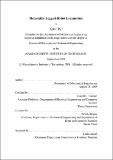Metastable legged-robot locomotion
Author(s)
Byl, Katie
DownloadFull printable version (5.751Mb)
Other Contributors
Massachusetts Institute of Technology. Dept. of Mechanical Engineering.
Advisor
Russell L. Tedrake and Neville Hogan.
Terms of use
Metadata
Show full item recordAbstract
A variety of impressive approaches to legged locomotion exist; however, the science of legged robotics is still far from demonstrating a solution which performs with a level of flexibility, reliability and careful foot placement that would enable practical locomotion on the variety of rough and intermittent terrain humans negotiate with ease on a regular basis. In this thesis, we strive toward this particular goal by developing a methodology for designing control algorithms for moving a legged robot across such terrain in a qualitatively satisfying manner, without falling down very often. We feel the definition of a meaningful metric for legged locomotion is a useful goal in and of itself. Specifically, the mean first-passage time (MFPT), also called the mean time to failure (MTTF), is an intuitively practical cost function to optimize for a legged robot, and we present the reader with a systematic, mathematical process for obtaining estimates of this MFPT metric. Of particular significance, our models of walking on stochastically rough terrain generally result in dynamics with a fast mixing time, where initial conditions are largely "forgotten" within 1 to 3 steps. Additionally, we can often find a near-optimal solution for motion planning using only a short time-horizon look-ahead. Although we openly recognize that there are important classes of optimization problems for which long-term planning is required to avoid "running into a dead end" (or off of a cliff!), we demonstrate that many classes of rough terrain can in fact be successfully negotiated with a surprisingly high level of long-term reliability by selecting the short-sighted motion with the greatest probability of success. The methods used throughout have direct relevance to machine learning, providing a physics-based approach to reduce state space dimensionality and mathematical tools to obtain a scalar metric quantifying performance of the resulting reduced-order system.
Description
Thesis (Ph. D.)--Massachusetts Institute of Technology, Dept. of Mechanical Engineering, 2008. This electronic version was submitted by the student author. The certified thesis is available in the Institute Archives and Special Collections. Includes bibliographical references (p. 195-215).
Date issued
2008Department
Massachusetts Institute of Technology. Department of Mechanical EngineeringPublisher
Massachusetts Institute of Technology
Keywords
Mechanical Engineering.